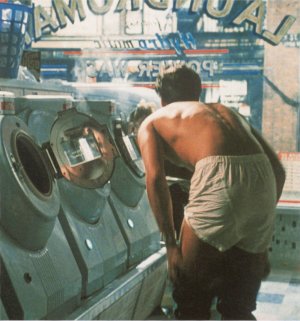

|
|
Advertising Agency: Bartle Bogle Hegarty (BBH) Client: Levi Strauss & Co. Brand: Levi 501 jeans Target: Mainstream; males 16-24 Release: 1985 Director: Roger Lyons Art Director: John Hegarty Copywriter: Barbara Noakes Account Director: Tim Lindsay Music: 'I Heard It Through the Grapevine' - Marvin Gaye Model: Nick Kamen Thanks to John Hegarty of BBH for the provision of a video copy. |
The commercial can be downloaded from
here (access is solely for students on this module).
In this famous 1985 television advert broadcast in the UK, model Nick Kamen stripped down to his
white boxer shorts in a
launderette so that he could wash his 501s. He did so to the strains of Marvin Gaye's 'I Heard it Through the Grapevine'.
The ad reached number 6 in a UK poll of 'The 100 Greatest TV Ads' in 2000 (Robinson 2000).
It kicked off a series of classic retro 50s-style ads which increased sales of Levi jeans by 800% by 1986.
It reputedly did almost as much for promoting boxer shorts.
John Hegarty, a founding partner of BBH, was the creative mind behind this ad.
The ad led to Nick Kamen becoming a one-hit wonder with 'Each Time You Break My Heart'.
Commentary 1: Mark Robinson
Kamen's 'Launderette' was shown for the first time on Boxing Day 1985. Thought up by John Hegarty and Barbara Noakes
of Bartle Bogle Hegarty, the ad campaign was designed to try and save Levi's flagging fortunes; the company was under
attack from all sorts of other fashionable brands. In short, Levi's (which has been going since the 1850s) were
becoming the sort of jeans worn by people's dads...
Research showed that the intended target audience for Levi's 501s - 15- to 19-year-olds - saw the United States
of the fifties and sixties as a cool time and place in history. James Dean, Elvis Presley and Sam Cooke all belonged to
this mythical, wondrous world. Unless the ad agencies came up with something new, the alternatiue was going with the
American campaign for 501s, which was all about how well the jeans fitted in the United States of Ronald Reagan and
MOR music. The image seemed the opposite of MTV and European chic.
So, director Roger Lyons was given the go-ahead to film an ad that showed drop dead gorgeous model Nick Kamen stripping
down to his boxer shorts, while flustered women and bemused elders looked on, and then sitting and waiting while his
jeans were in the wash. All this and Marvin Gaye thrown in too. (Except it wasn't actually Marvin Gaye but a newly
recorded 'session' version of the song - though the original was later re-released off the back of the ad and
entered the charts all over again.
'Grapvine' was the first of four Levi's-related songs to all make the Top Ten, a feat that made advertisers realise
that choosing the right music was of paramount importance because it really could help push a product on TV. They call
it 'integrated marketing' - and it meant a single in the charts and an ad on the box simultaneously, as well as the
'501' logo alongside the artist's name on the record sleeve in every record shop in Britain.
Kate Thornton was a schoolgirl at the time and remembers the effect that Kamen's striptease had on her. 'I remember
hearing that the ad was running at a cinema before a movie - and I hadn't seen it on the telly at that point. So I
went to the cinema just to see the ad,' she says. 'The commercial made those jeans sexy at a time when Levi's were
struggling to make their product appealing to women of my age - and really that's where the big spenders come from.
Suddenly those jeans became a must-have item. I only wanted them because Nick Kamen wore them and took them off.'
Thornton wasn't the only British teenager to feel that way - consumers wrote in to Levi's in their thousands
asking for pictures of Kamen. Meanwhile, sales of 501s shot up by an incredible 800 per cent in the wake of the ad,
which eventually had to be taken off because the company couldn't produce enough jeans to meet the new demand.
By 1987 sales of Levi's jeans were reported to be 20 times what they had been just three years earlier. The
commercial also boosted sales of boxer shorts to a record high- though the ad agency only put Kamen in a pair of
boxers because they weren't allowed to show their hero in a pair of jockeys. And it wasn't just teenage girls
buying the jeans - and with it a little bit of Nick Kamen; boys too were impressed by what Kamen could do. 'The
ad said: "Wear Levi's jeans and you'll be a rebel without a cause," says psychologist Dr David Lewis. "You'll be
able to alienate older people - who young people despise anyway - and you can be cool."
Inevitably, Nick Kamen was suddenly flavour of the month. Madonna wrote a song for him called Each Time You
Break My Heart which made it into the Top Ten. Kamen was soon a fully-fledged pop star - but his new career
was short lived. Subsequent singles failed and Kamen moves to Los Angeles where he was to live for a time with
British television presenter Amanda de Cadenet. 'There wasn't life for Nick Kamen after Levi's because he broke the
rule - he talked,' says Thornton. 'We just liked looking at him. It was as simple as that. He was a model and he
just had these smouldering beautiful looks... But fundamentally he was to be looked at and lusted over - and never
to be taken seriously.'...
Source: Robinson (2000), pp. 119-121
Commentary 2: Greg Myers
You might think the advertising agency with the Levi's
account had an easy job. After all, though the company had a rather disappointing
year for profits this year, there remains a huge demand for jeans around
the world. In the US they are still reasonably priced as the basic, non-designer
jeans; in the rest of the world they carry a price premium and instant
recognition. They also carry all sorts of associations with youth, Americanness,
and rebellion. But it is just this status as an institution that makes
them something of a challenge to advertise. At the moment their market
share is being eroded by designer labels and budget-priced own labels.
In terms of the Four Ps, they are considering the product (should they
market more or fewer cuts?), the promotion (but ordinary advertising or
promotions might actually undermine these core meanings of the brand),
and the placement (but wider distribution might have its dangers, so, for
instance, Levi's has tried to keep them from being sold in truck stops
in the US and Tesco supermarkets in the UK). Cuts in price might not be
a possibility, since that would run the risk of their being seen as a cheap
alternative.
The brief given to the agency that has the account
in the UK, Bartle Bogle Hegarty, was that they get across the idea that
Levi's were the original but still contemporary jeans. They had to somehow
set them apart from the increasingly fierce competition, and show that
design features had a tradition behind them, while the style could change
subtly. They have done this in a series of ads since 1986, many of which
have won awards in the industry and many of which have been discussed by
journalists and academics (Corner 1995). If we look back over five of these
ads, from a series of more than 30, we can see the outlines of the campaign
underlying the particulars of each ad...
Textual Analysis
The most basic level of this analysis is to look
at the signs themselves, the physical form in which you get the message.
The signs could be spoken words, or written words, or pictures, sounds,
music. With this series, there are no spoken words; it is the music that
people remember...
There are no spoken words in these ads -- that in
itself is a striking deviation from conventional ads, which nearly always
have an offscreen or onscreen voice telling you how to interpret the images.
Here you are left with the feeling that you are interpreting them yourselves.
Another kind of sign is, of course, the written words. They are simple...
[There is]
not... a striking slogan...
The ads have the same basic story,
in which we have no at idea at the beginning what the ad is for. We get
caught up in teasing revelations, and then there is the surprise in which
we see, first, what the images meant, and then, second, apply them to the
product. Each as has some new elements of structure... But it is the same
basic plot. Within this story there is also a visual structure...
The ads... establish a stylized past, and position
us a voyeurs, before a final joke emphasizing a product claim. Let's see
how this structure relates to the kinds of issues I have raised in branding:
the use of the Past, the Position in relation to other brands, the Practices
associated with it, and the shifting Paradigms of meaning systems.
Past
The key problem for Levi's is to keep the sense of
their being genuine American work clothes, while opening them to contemporary
associations. John Hegarty explained that with the first in the series,
"Launderette", he wanted a general sense of a mythical America. But America
and Americanization can carry all sorts of negative meanings around the
world... Here is Hegarty's comment:
Position
Up to the last five seconds of these ads, many first
time watchers are probably puzzled about just what is being advertised...
But the ads are not at all unrelated to the product, the ways some clever
ads seem to be. Levi's can't afford this -- it is in a ferociously competitive
market where the competitors make clever ads too. In a sense, the whole
ad is a product demonstration of just how good the jeans can look, or rather,
just how good the body can look that is under the jeans. Only in the last
seconds is the erotic tease transferred to Levi's...
Practices
Where does one wear Levi's? When I was in college,
Levi's were student clothes, manual work clothes, counterculture. Some
time after that, and after I stopped wearing them, they entered into other
settings. They were able to draw on these associations with counterculture
and informality, and yet be accepted as clothes for older people in more
formal situations -- such as President Clinton. The company tried to adapt
to this shift, recognizing that middle aged men and women, such as most
university lecturers, are different shapes from university students (as
you will have noticed). So they sold jeans with different cuts, and developed
ads aimed at this market, and developed a new brand, Dockers. The original
Levi's 501s remained undeniably hip, but part of the appeal was that one
could do things to personalize them -- shrink to fit, cut, patch, bleach,
dye. Some jeans have tried to keep up with these alterations, selling jeans
already prewashed. But it is in the nature of such alterations that they
cannot be entirely brought within the marketing plan. People are making
the uniform commodities their own.
Paradigms
These shifts in the uses of jeans go on against larger
shifts in meanings. What it means to be American has changed radically
throughout the last fifty years, from GIs to the Beats to Vietnam to the
Gulf to Friends; that is why John Hegarty is so careful to set his ads in
a mythical, timeless America. Notions of the erotic change too... [some
ads] mark current fascinations with boundary crossing. Associations with
manual work change as most people are employed in services. The uses of
tradition have, if anything, expanded in this period of rapid change; paradoxically,
Levi's turns to travellers, drifters, and fugitives for its emblems of
rootedness. This is not the place to trace the workings of detraditionalization;
my point is just to stress that this timelessness is the product of a particular
place and time.
Source: Myers 1999, pp. 23-8
Commentary 3: Sean Nixon
By now the visual scenario is established. The camera has opened up a scene that is not recognizably of the present.
We have entered a space whose key signifiers (the washing machines, the women's hairstyles, clothes, the music) allude
to a glamorized 1950s/early 1960s cultural landscape.
The anonymous hand that has opened the door and led us into this urban launderette is revealed to us: it belongs to
a striking looking young man. He pauses inside the doorway. His appearance confirms the historical periodization
already established by the music, the set and costume; his hair is greased in a soft quiff, and he is wearing a
plain T-shirt and denim jeans.
He nonchalantly removes the sunglasses he is also wearing and glances around the launderette, taking in the
situation. The camera moves onto him in close-up: his skin is seamless, olive-brown and glistening; his eyes are dark.
None of the other users of the launderette appears to know or recognize him. A danger and tension is marked around him
as he moves towards a machine. Eyes begin to turn to him. The mother pulls her boys away from gawping at the young
interloper, as he pours nuggets of soap powder into a machine.
The slightly troubling self-containment - and self-consciousness - of the young man becomes clearer as the narrative
unfolds. Where are his bags of washing? Where is the unglamorous weight of domestic laundry? With one more controlled
glance across the launderette, the young man pulls off his T-shirt to reveal a firm, smooth torso. He then undoes and
slides off the belt to his jeans, unbuttons them and pulls them down and off over his boxer shorts and thighs. Both
items are thrown into the washing machine. Confident in this performance, he casually takes up a seat amidst the
gaping mouths, giggles and frowns of the other users of the launderette.
A final shot of our young 'hero' sitting in his white boxer shorts and white socks is framed by a line of copy and
the trademark label of the object of his daring washing ritual: the red tab 501 shrink-to-fit indigo-blue jeans...
Why start with this invocation of a 50-second television and cinema advertisement that ran in the UK from Boxing Day
1985 until the Autumn of 1986?... First, it brings together a particular and distinctive set of codings of
masculinity... The foregrounding of the surface of the body is central to Launderette's representation of
masculinity. Through the choice of camera shots, an intensity is produced in the framing of the masculine body in
the advert. As Nick Kamen, the model, undresses a series of looks are formally established that bring the viewer's
eye close up to his face, chest, arms, thighs and bottom. A fragmentation of his body is produced in these
shots that undercuts the more established codes of aggression and power associated with masculine display. The
revealed torso and Kamen's features combine to allow the display of both developed (but not too hard) masculinity
and a marked softness and sensuality connoted through his soft lips, eyes and skin-tone.
Individualism is also a key to the representation of masculinity in Launderette. The narrative of the
advert and its mise en scène signify the young hero as stylistically self-conscious and, through this, as
separate from the dreary adults who sit and watch him in this functional domain. After all, the ritual that we
witness is guided by his desire to achieve the perfect fit to his jeans through the shrinkage produced by washing.
The shrink-to-fit jeans, the button-fly, the connotations of the model's 'look' and the setting of the launderette,
together signal a pre-permissive moment that is also important to Launderette's distinctiveness...
Immediately upon its broadcast, the advert (together with its companion advert, Bath) prompted a plethora
of commentary and analysis... What these often diverse commentaries shared was the sense that Launderette was
in important ways exemplary of some wider shifts occurring in popular representations of masculinity. These were
shifts that by late 1986 could be confidently condensed in the figure of the 'new man'.
One account offered a particularly lucid reading of Launderette and the shifts in masculine scripts connected to
style and individual consumption associated with the 'new man'. In an important article, Frank Mort (1988) argued that
what marked out the new imagery was the way it offered a more sexualized representation of the male body in ways which
drew on the codings traditionally associated with representations of femininity in consumer culture and, in addition,
resisted the assertion of a fixed or true sense of maleness in its styling of appearance. The significance of this
for Mort was that such codings pointed the way to a radically different version of masculinity; one characterized by
a more self-conscious sense of maleness.
Source: Nixon 1996, pp. 1-3
Commentary 4: Frank Mort
The Levis ads were a tongue in cheek parody of 50s style. Young men in launderettes - not a common sight then in
Britain or the US! Mean and moody looks in inner-city streetscapes reference, albeit in sanitized and glamourised
form, unemployment, making one's way in a world in which the young - and now unusually young men - are short on the
crucial element it takes to get by in a capitalist society - money. They have only their looks, their style, their
bodies to display and sell. These are cultural images framed both by recession and by the more fluid sexual scripts
of the 80s, rather than 50s affluence and tight gender roles...
The modern cityscape was where our Levis hero was launched. The James Dean type loner; vulnerable and arrogant,
soft yet muscular, tough but tender... The story lines were really much less interesting than the visual messages
coming over about the male body. This is where new man advertising breaks the rules, frustrating traditional codes
of masculinity. In other words, it's where marketing imagery enters the realm of sexual politics.
Two features are especially worth noting. First, the fracturing and sexualization of the male body, condensed around
the display of the commodity - the jeans. Cut close-up focus on bum, torso, crutch and thighs follows standard
techniques of the sexual display of women in advertising over the last forty years. But now the target is men.
More to the point, male sexuality is conjured up through the commodity... It was the display of the body
through the product that was sexy. Belt, button-flies, jeaned thighs... was what made the ads erotic,
less the flesh beneath. And so the sexual meanings in play are less to do with macho images of strength and
virility (though these are certainly still present) than with the fetishized and narcissistic display - a visual
erotica. These are bodies to be looked at (by oneself and other men?) through fashion codes and the culture of
style.
Something uncomfortable, transgressive even, is going on in these images...
The company took their lucrative advertising account not to one of the corporate giants, but to the 'creative'
team of Bartle, Bogle and Hegarty... BBH are self-consciously 'creative'... It is a shift from advertising
as an informational medium, with the copywriter and rational argument in dominance, to the growing use of
'emotional imagery', resting on the visual skill of the director.
Source: Mort 1988, pp. 193-209
Commentary 5: Frank Mort
[The first ad was Bath]
The second advert, Launderette, depicted a more public landscape of consumption. The image of a beefy,
uniformed GI, along with other establishing shots, again of post-war America, paned to the entry of another
youth, now in a Laundromat. The atmosphere of expectancy and authenticity was enhanced by the sound track... drawn
from Marvin Gaye's 1968 Motown hit, 'I Heard It Through the Grapevine'. The young blood with Latinate good looks checked
his image in the face of a giggling female audience. Stripping to his boxer shorts, he slung his 501s into the
machine for a customised wash. As he undressed, the camera again moved in close up, ficing the product with a rapid
scan over the model's bum, waist and thighs.
Bath and Launderette ran for three months, strategically placed between contemporary youth viewing
slots, such as Channel Four's soap opera, Brookside, and their music review programme, The Tube.
They were backed by a year-long cinema screening and a substantial press campaign. The press work was carried
primarily in The Face, with additional material appearing in the rest of the style press. They ran a variant
of the themes announced in the television commercials, but with a different nuancing. Immaculate images of Levi's
jeans were arranged alongside artefacts styled by international fashion leaders such as Gaultier and Paul Smith.
Designer watches, loafers and leather jackets set off Levi's product in bleached wood or matt-black surroundings, to
produce heavy signifiers of connoisseurial taste. They referenced an élite culture whose meanings were only
recognizable to those 'in the know'.
Levi's had a profound image problem. The company had first traded 501s to British youth in
the early 1960s. The product had rapidly acquired a cult status... Challenges from American competitors in the
1970s had forced a marketing rethink. But Levi's decision to diversify into casual clothes had proved disastrous.
In the early 1980s it was common knowledge among manufacturers that the firm's market share had slumped...
The advertising brief was strategic; to reposition Levi's against its competitors by foregrounding the authentic
value of the product. Tim Lindsay, BBH's account director at the time, put it succinctly. The approach was
'to convince people that 501s were the right look and the only label you should be wearing'... BBH drew heavily on
the concept of niche-marketing, and on the theories of style leadership, to formulate the plan. Lindsay... spoke about
three distinct groups targeted by his agency's advertising: 'stylists', 'early adopters' and 'young men in the
street'...
The alliance of creative advertising and marketing with the avante-garde discourse of style was evident at every level
of BBH's influential campaign for Levis'. The synthesis of these two approaches to consumption was present as much
in the intellectual planning as in the imagery, which was drawn on to represent young men to themselves. Hegarty
himself had long been interested in the concept of style leadership... Hegarty's art-directed commercials raided the
vocabulary of the taste élite. Retrospective imagery, drawing on the icons and artefacts of earlier moments of youth
culture and reinforced by music. was integral to his overall aim: to achieve classic branding via mise en scène.
The creative director's gloss on his use of this heritage montage was telling. As he put it, the past could be very
acceptable, but it had to be 'relevant to what's going on now'. Effectively packaged and 'air-conditioned', retro style
could enhance the personal qualities of the brand, reinforcing the message that the jeans were your 501s.
At the heart of these efforts to establish cultural value was the representation of masculinity. Dramatic images of the
male physique anchored Levi's product. The bodies of both television models were displayed clothed, encoded in and
through the commodity. Close-up shots of face, skin and more private parts achieved a double effect. Surfaces were
eroticised and dissected. Sexuality was evoked in the fragmentation of the body, via the fetishised display of the
jeans. For these effects BBH drew heavily on the formula rehearsed by Ray Petri in his style narratives. It was no
accident that the model used for the Launderette commercial was Nick Kamen, already established as one of
Petri's favourites. The visual result was both intimate and showy. The looks and glances given off by the models
invited two different kinds of spectatorship. Narcissistic self-dramatisation - the incitement to look self-consciously
and to be looked at - was coupled with a more public ritual of commodity spectacle. Moreover, the look inscribed
in these exchanges, between the actors and their imaginary viewers, suggested a knowingness about something more than
a desired product. Like Petri's photo-shoots, the dialogue was redolent with the shared knowledge of a specific
culture of masculinity.
Source: Mort 1996, pp. 108-112
Commentary 6: Mark Simpson
The new campaign for Levis in the UK, launched with Launderette, increased sales by 800 per cent in the first
five months [Campaign, 1985]. A powerful new force had clearly been tapped by the advertising agency responsible, Bartle Bogle. In
addition to its astonishing success, the boldness of the campaign and the massive media response it created made it
appear as if the revolution in the representation of the male body had been invented by them.
It had not, of course. Like the nostalgia their ads exploited, their treatment of the male body took its reference
points from the 1950s, from films like A Streetcar Named Desire...
It was the 1950s that put the naked young male stud in front of the camera for the first time. It was the 1950s
that invented another way to sell close-ups of young men: rock and roll. It was the 1950s that invented the mass
consumerism that turned 'feminizing' men into big business. And it was the 1950s that invented that ultimately
desirable product (and consumer): the 'teenager'.
Bartle Bogle and the host of other advertisers who followed in their wake took the nostalgia for the 'innocence' that
era came to represent in the 1980s but used it to present the flip side of the 1950s myth - awakened desire.
The product itself embodied this. Jeans in the 1950s were a signifier of the desirable young man, 'the rebel'
(the first shot of Kamen in Launderette is of his jean-clad crotch). Issued to GIs in the Second World War
and the Korean War, they became popular with the men and were worn, so the story goes, by those who went on to
attend college on the GI Bill. Jeans thus became associated with the young man who had 'seen the world' and lost his
innocence and his dependence on his family - a self-assured individual intent on pleasing himself. A male with
the privileges of manhood and the freedom/ambiguity of boyhood: a male symbolizing awakening desire, untramelled and
outside of family regulation. Thus the young American male in jeans became a symbol of rebellion - rebellion
against the de-sexing of the masculine image that had gone before, a public statement of the desirability of the
male body.
Not surprisingly the 1950s was also the birthplace of modern gay culture, itself intimately linked to the
development of mass consumerism. Hence gay men had kept the flame for the 1950s long after their fashionability
waned. Leather jackets from The Wild Ones, jeans from Giant and T-shirts from Streetcar had
remained constant features of the gay scene on both sides of the Atlantic. The iconography also fed into the
'clone' look of the late 1970s and early 1980s: motorcycle boots, white T-shirts, hair cropped to look like a
Korean War draftee, and well-worn and possibly ripped Levis 501 jeans. It was no coincidence that this image (bar
the moustache but including the earring) became a mainstream male fashion in the 1980s or that the Levis campaign
that was in the vanguard of this 'homosexualization' of young men (tender young men between 16 and 24 at that)
[Observer Magazine, 1993] was spearheaded by the 'invert's striptease'.
Of course, gay men, like blacks, as an 'extravagant' minority on the margins of society, had long provided a rich
supply of fashions for capitalism to appropriate and bring into the mainstream. But in the 1980s straight men were no
longer being sold just cologne or disco: instead the whole package was being promoted - the queer lifestyle,
the individual young man indulging his desires outside the heterosexual family.
Narcissistic, sexy, single young men happy to throw their clothes off for the camera became the advertising ideal.
Nick Kamen, as well as stripping for us, is doing his own washing. Where is his mother or girlfriend, the
'little woman' who in ad-land takes care of this kind of chore for her man? He is single, unafraid, flouting
respectability and passively inviting our gaze: he is 'queer' - his sexuality is outside regulation...
Of course, these men/boys are not completely beyond control, they are not that queer. Their 'promotion of
homosexuality' is framed in such a way as to blur desire into identification, to reassure the boys buying
homoeroticism that they are making a heterosexual identification. In Launderette Nick Kamen is given an
audience of giggling girls, marking him as heterosexual, mediating his image, and giving the male viewer an
opportunity to enjoy the 'invert's striptease' from a heterosexual perspective, imagining he is viewing the
male body through the girl's eyes...
But even the heterosexual framing of these ads is at best ambiguous, given its context. In Launderette
a young boy sitting reading a comic next to the door is the first spectator we see. When Kamen enters, his
crotch is at the boy's head level; the boy turns to look up at him, then he and his twin brother follow Kamen
to the washing machine, watching him intensely (although they are scooted away by a harrassed mother who gives
Kamen a filthy look conveying, perhaps, in its mixture of envy, desire and disdain, the look
heterosexual society gives the queer)...
Source: Simpson 1994, pp. 97-100
Commentary 7: Mark Simpson
It may appear ironic that advertising for men's clothing sold male nudity to the world, until, that is, you
consider that what the advertisers did right from the beginning was to fetishise a certain type of masculinity
and attach it to the commodity. This was the tough-but-tender, 'authentic' masculinity of Fifties America, roll 'n'
roll, James Dean in Rebel, and Marlon Brando in The Wild One, a masculinity, in other words, which
gay men had enthusiastically worshipped and attempted to appropriate by, well, wearing Levi's. Advertising sold,
to its target audience of straight males aged sixteen to twenty four, a 'gay' fantasy about a commodity which had
for years been the 'gay jeans'.
For this reason, and the fact that representing men as sex objects had previously been the preserve of gay porn,
many Levi's ads looked rather queer. Of course, by making sure that those seen to be enjoying the naked model are
aways female... the ads try to ward off this possibility. But doing so merely serves to highlight the
'non-heterosexuality' of the ads, that in Levi's-land sexual difference no longer calls the shots, men are the
passive object of women's gaze, and masculine does not automatically map on to 'active' and feminine on to
'passive'...
In a sense, what is being sold with Levi's jeans masculinity is the 'gay lifestyle' itself: one of the key
features of Levi's man is that he is a single young man taking his pleasures where he pleases - Nick Kamen, let us
not forget, was doing his own washing, where was the 'little woman' in his lifewho was supposed to take care of
these things?...
But perhaps the most fascinating aspect of the Levi's ads is the way that they push the commodification of the
male to its logical conclusion. There has always been more than a hint in Levi's commercials that the jeans are
intimately associated with the ultimate male accessory - the penis...
The suggestion that the jeans are a type of phallus which can be put on and taken off also implies that Levi's are
a kind of drag and that gender itself has been commodified...
Source: Simpson (1996), pp. 229-31
Commentary 8: Suzanne Moore
Something had happened. After years of women complaining about the objectification of their bodies, we find ourselves
confronted with the male body on display: cut up, close up and oh! so tastefully lit. For some time now such images
of men have been quietly slipping into the mainstream via films, videos and - above all - advertising, selling us
everything from jeans to make-up and baby clothes...
What's so interesting is that many of these images are culled in both form and content from a long tradition of
softcore homoerotica, and yet they are being aimed at, and consumed by, women as well as men. Moreover I want to
argue that they appeal to women precisely because they offer the possibility of an active female gaze...
Although Rambo still rules in some quarters, competing images of masculinity are coming to the fore which do
show men as desirable. Such images do not suppress desire between men and so their narcissistic elements are made
explicit. These images offer the possibility of being looked at with the 'eye of desire', whether it is a male or
female eye. Their capacity to disturb lies in their appeal to both men and women.
The following passage is from an article in the free London magazine Girl about Town:
The Levis 501s advertising campaign was one of the most successful ever, managing to connect Levis to a nostalgic
longing for a simpler time... But when the camera focused on the leather belt sliding off, the assured unbuttoning
of the flies... a different kind of longing altogether was evoked.
This wasn't the first time, of course, that the male body was represented as an object of desire - from the silent movie
stars to Smash Hits there is a long if uneasy history of male pin-ups. What was different was that, in a
mainstream context, here was a male body coded, in Mulvey's apt but awkward phrase, for its 'to-be-looked-at-ness'
Mulvey 1975). The usual mechanisms that signal erotic spectacle had crossed gender boundaries. 'Nowadays, the
half-naked body you see on TV ads making tasteful love to a bottle of scent won't necessarily be a woman's body'
(Saunders 1987).
As it becomes more problematic to show naked women in advertisements, so naked men come to the fore...
In the Nick Kamen ad the relay of looks between the people sitting in the launderette sets him up as object of the
gaze - so we too can look. If, in the past, erotic images of men's bodies carried with them the threat of male
homosexuality and therefore had to be rendered powerless in some way by being feminised or wounded (the agony is the
ecstasy), it now seems possible to represent the male body as a pleasurable object on condition that this
pleasure can be contained within a narcissistic/auto-erotic discourse.
The slippage into and from homo-erotica is of course inevitable. Unsurprisingly, many of the images I have mentioned
have been discussed from a gay male perspective (see for instance the work of Mark Finch... and
of Frank Mort), which tends to underestimate the pleasure that women may derive from such images. Thus Mark Finch
can write about Dynasty:
On the contrary homo-erotic representation, far from excluding the female gaze may actively invite it.
What's more, as many shrewd business men have realised, it sells to young girls.
Source: Moore (1988), pp. 44-7; 54-5
Commentary 9: Tim Edwards
Their associated advertising has gained serious attention across media, marketing and academic circles alike
(Barthel 1992; Chapman and Rutherford 1988; Mort 1996; Pumphrey 1989; Simpson 1994, 1996). A consensus or story
has developed since to explain their success, essentially told as follows. At the end of the 1970s and in the
early 1980s, the jeans market was increasingly saturated and so diverse that nearly everyone of every age, class
or area had a pair. In particular, so the story goes, Levi's were losing their market share. The solution lay in
a semi-legitimate reclamation of authenticity: Levi's as the original and longest-lasting jeans, also mythologized
by 1950s Hollywood icons including Marlon Brando and James Dean. Significantly, this was not the end of the story
and the two earliest campaign, namely 'Bath' and 'Launderette', were blatantly sexual, as barely clad and
glamorous young men were caught in the act of getting their jeans body-clinging wet or unbuttoning them oh-so-slowly
in the launderette. This led, not surprisingly, to a serious case of product fetishism as 'it was the display of
the body through the product that was sexy' (Mort 1988, p. 201). The button-flies were critical as constant attention
was drawn to accentuated male genital anatomy, an idea played upon previously in the gay community. Given the
gimmickry and the simultaneous appeal to authenticity and sexuality, success was not surprising. Levi's now have
something of a cult following, whilst the soft-core, prick-teasing advertising campaigns maintain their grip on
the market...
Following such media and academic attention, it is perhaps worth examining the elements of these points in more
detail. Firstly, it is commonly asserted that authenticity was critical to the success of the advertising campaigns:
the claim was that Levi's 501 was the oldest style of jeans and therefore the original, and all the others were
either fakes or copies - which was, of course, only partially true, as 501 jeans underwent numerous modifications
in design since their inception in the late nineteenth century. This is of secondary importance as it hardly mattered
whether the claim was true or not, for it remained an important part of the marketing campaign and, in implication,
an equally important part of its success. But whilst authenticity may form a major part of the justification
for purchase, I suspect its importance in motivation, or indeed in stimulation, of desire and
interest, is a lot less.
This leads on the second factor: that of the sexuality, or perhaps simply sexiness, of the advertising campaigns.
This is a rather underplayed point elsewhere, as sex is a common and well-known tool in any marketer's kit... But
the sexuality of the adverts is worth some consideration. An initial point of contention here concerns quite where
the sexiness comes from, for as much of would seem to come from the (often very physically attractive) characters
as from the frequently off-camera product - from the wearer as opposed to what is worn. The wearer is male rather than
female despite the manufacture of 501s for females as well. This has been seen as a significant case of role-reversal
in the viewer-viewee relationship, particularly when, as was the case with the first advertisements, the male is seen
alone or is constructed directly as the looked-at gender...
Thirdly, there is a consistency of attention to the details of the product and, in particular, the flies. This is the
factor which, I think, constructs the sexiness of the adverts: the accentuation of the look/don't look and see/don't see
configuration. In this sense, the Levi's adverts are oddly conservative and strictly speaking, very phallocentric as the
model's cock is constantly hinted at and yet only momentarily glimpsed through the product, a point explored
more fully in Frank Mort's work (Mort 1988). In particular, it is the fact that we are not allowed to look at the
male that reinforces the construction of the female as the still all too looked-at gender. The difficulty here, though,
is that the distinction is still undermined as it remains the male who is the overt focal point, off-set with the
defensive phallocentrism of his overall representation. This is similarly a constant issue in pornography as male
genital anatomy wholly fails to live up to its phallic connotations and ends up supported through other factors
including muscularity, masculine dress uncluding uniforms and denims, and the masculine activities and environment of
the outdoors, locker rooms, gyms, showers or workshops (see Edwards 1994).
This leads on to the fourth point that, despite all the disputes, the adverts do constitute an example of
the reconstruction of masculinity through looking, through sexuality, and through consumption. The actual patterns of
consumption in this case, though, are rather mixed up, as Levi's 501 jeans, whilst still high sellers overall,
have a particular appeal for students as well as other fashion-conscious youth groups and, most importantly,
a near mythic appear for the gay male community. Many young, and some older, men, straight or gay, now refuse to wear
anything else and Levi's 501 jeans have gained a status that is as cultist and specific as it is diluted and general.
A final, and often neglected, point is that this development of product fetishism has accompanied a simultaneous
fixation with physical appearances and, in particular, a muscular physique (Triggs 1992). The hunky young guy guided
sexily into and out of the flies of his 501s is, without exception, a white, clean-cut, decidedly mesomorphic model. It
is, I think, a mistake to try to separate these points of dress and physique, for they not only mutually complement
and enhance one another, they are fundamentally mutually dependent upon one another, as we cannot, yet, look
at a man in other than phallocentric terms. To put it more simply, if he was not a defensively heterosexual and
aggressively muscular hunk, we could not look at him at all, as masculinity itself would be called into question
for the artificial and phallocentric construction it is. In conclusion, we are increasingly asked to not see
masculinity, and this is the process of imaging masculinity.
Source: Edwards (1997), pp. 51-4
Commentary 10: Kenneth MacKinnon
Today, the Levi 501s commercial of 1986, in which Nick Kamen stripped to his boxer shorts, coolly disregarding the
looks of other launderette clientele (largely female), represents probably the most upfront visualisation, to that
point, of the commoditised male body. The desirability of Kamen's body is acknowledged in the looks, indicating
variously shock or pleasure; his non-return of the looks can be taken to signify his indifference to public
opinion, his (male) power not to acknowledge his body's commodification, or else his confident narcissism.
There is emphasis in the commercial on the 1950s imagery of female hairstyle and dress and, through the launderette
window, on the sort of car associated with the period. Customers, of both genders, seem largely, but not
exclusively, determined to mind their own business, despite Kamen's display. While it added emphasis to the sense of
period with its retro soundtrack, the commercial featured several startled reactions, particularly from females in
close-up. These women seemed to be secretly thrilled, while only just maintaining a decorous façade of propriety.
Kamen seemed passive, unthreatening, yet quietly confident and, paradoxically perhaps, in control. These
qualities can be found in advertising's female subjects and male subjects for the decade after the cinema and
television exhibition of this commercial.
This commercial, widely shown - and widely parodied - on television and on cinema screens, has been variously
identified as marking the emergence of underground 'gay' erotic images into the mainstream and thus a
redefinition of male sexuality. It has also been taken as announcing popular culture's ability to absorb the
fragmentation and sexualisation of the male body in a way that was once confined to the use of the female body
in advertising and other contexts. Significantly, it seems possible to claim from at least this point that the
male is eroticised through products (jeans, men's cologne, hair gel), that the male becomes overtly and
undisguisedly commodified.
If Levi 501s sales depended increasingly from the mid-1980s on the desires created and/or fed by visuals of belts
slipping away from jeans, of flies being unbuttoned, jean-clad male bottoms slipping into bath water, possibly
the most overtly erotic images of the male can be linked with Calvin Klein...
Source: MacKinnon (1997), pp. 98-100
References and further reading
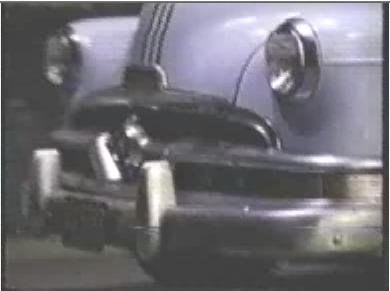
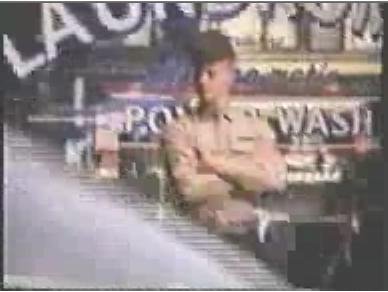
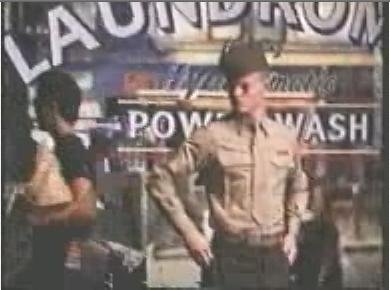
Shot 1a
Shot 1b
Shot 1c


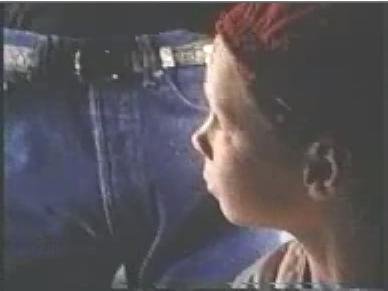
Shot 2
Shot 3a
Shot 3b
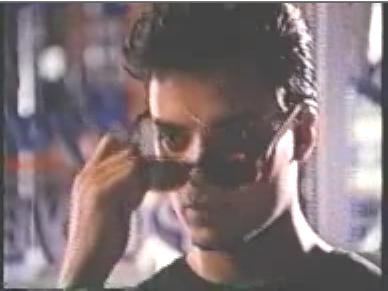
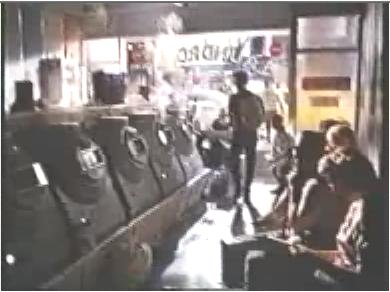
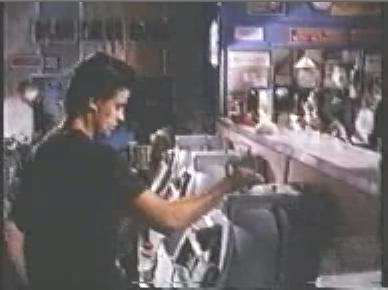
Shot 4
Shot 5
Shot 6

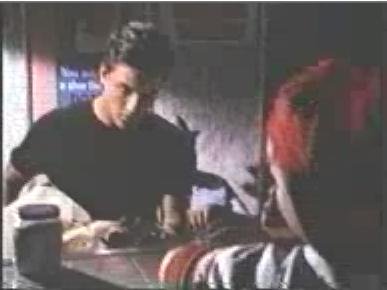

Shot 7
Shot 8
Shot 9
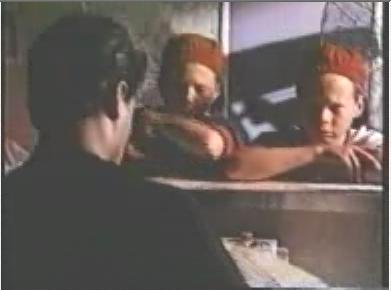

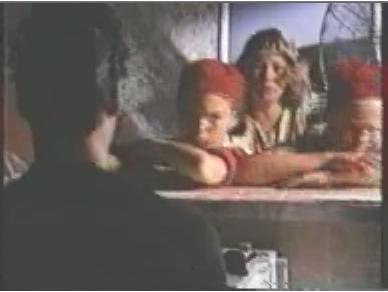
Shot 10
Shot 11
Shot 12
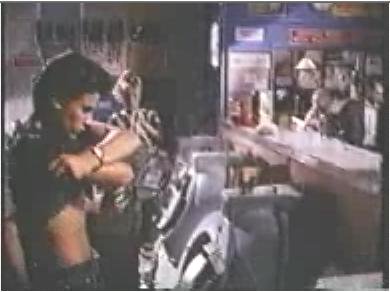
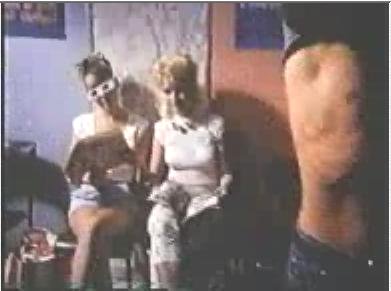
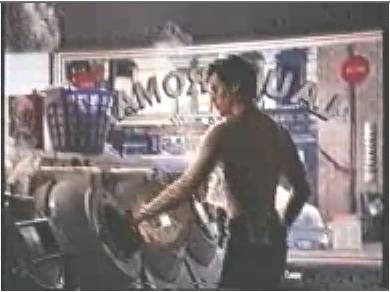
Shot 13
Shot 14
Shot 15
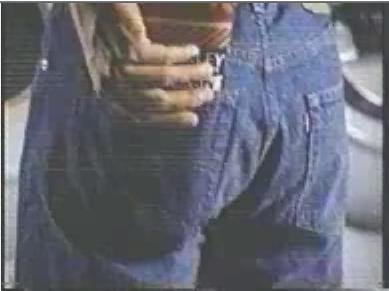
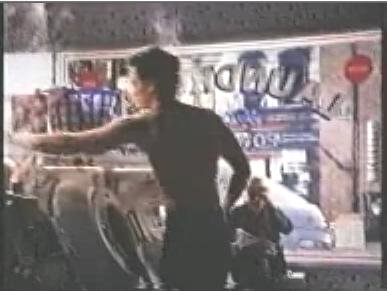
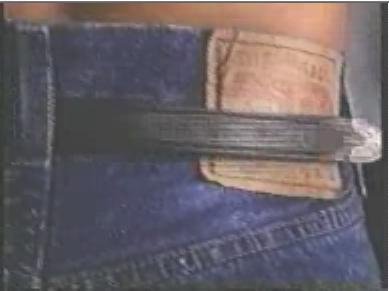
Shot 16
Shot 17
Shot 18

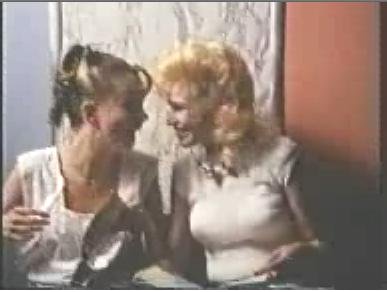
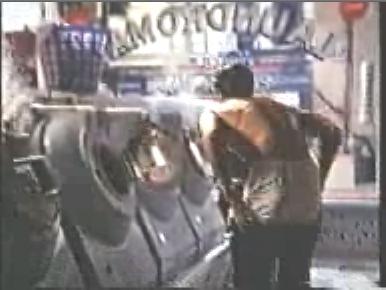
Shot 19
Shot 20
Shot 21
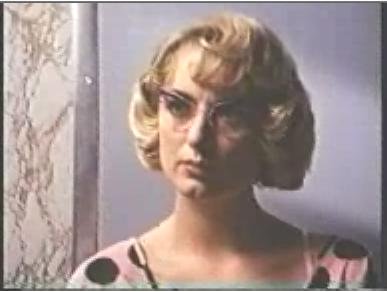
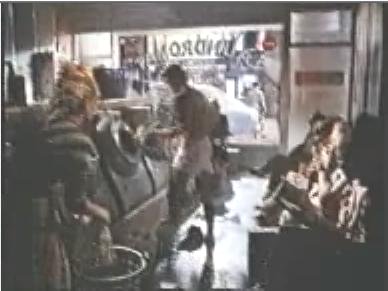
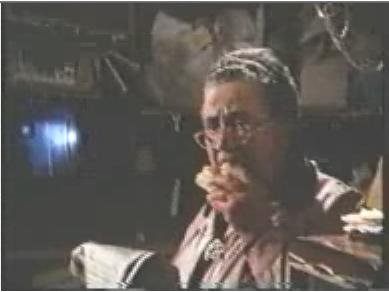
Shot 22
Shot 23
Shot 24
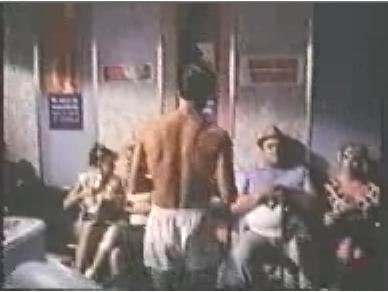
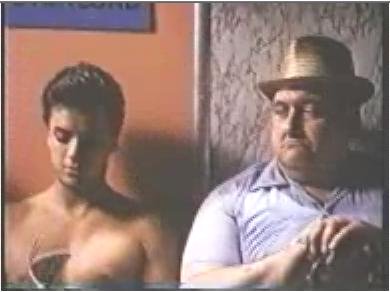
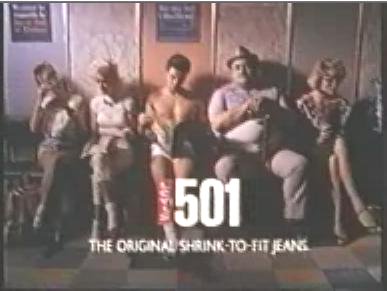
Shot 25
Shot 26
Shot 27

Shot 28
The opening bars of Marvin Gaye's hit I Heard It Through the Grapevine are among the most evocative in television
advertising history. For a whole generation, at least, those few moody seconds only bring one image to mind - that of
model Nick Kamen walking into a launderette. The ad might not have been set in the eighties (more like a mythical
fifties), but for many those first few seconds can evoke memories of an entire decade. Kamen... only got the part
on condition he lost weight...
Constructing Heritage: Levi's 501 jeans
Now let's look in more detail at how these features
work within a strategy.
I thought it would be more interesting to do the
ad with a period look. The 1950s idea wasn't in the brief. It just happened,
and out of that we established a mythical period for Levi's. Grapevine,
the music that backed the ad, was a 60s not a 50s song -- it came to me
simultaneously and there was no real logic to it. The aim was to portray
the US without the US being boring -- a US no-one could object to. (Campaign
20/9/96)
Almost all the later ads were set in this mythical period
America, with elements of anachronism. The music may not be from the same
period as the pictures, but they work together to suggest a sort of pastness.
This past overlaps with a sense of the past as youthfulness. It is suggested
by such devices as jerky film, suggesting the older film with fewer frames
per second, or with colours reminiscent of those from now faded technicolor,
or with references to styles of photographers or filmmakers.
The door of an urban launderette opens. Marvin Gaye's song, 'I Heard It Through the Grapevine' starts up on the
soundtrack, its taut, soulful groove laying across the unfolding scene. A row of arcane looking washing machines
fill the space the camera has entered. The launderette is busy, and steam rises from the machines. Two young women sit
together on chairs reading magazines. One wears crazy, white framed '3D' glasses. Both are in long, flared skirts and
wear their hair in high pony-tails. The camera introduces other users of the launderette: a pair of brothers in
red reversed baseball caps who are restless and inquisitive in this functional adult domain; their mother, wearily
attentive to her sons' movements and to the washing to be overseen and tended. A grumpy-looking man in a hat sits
just down from the two young women; a bespectacled lady reads next to him.
1981 to 1984 saw a slump in Levis brand share of the UK market. 'Bath' and 'Launderette' were to spearhead the
company's recovery. Targeting the all-important 16-24 year old male with a four million package in Britain alone,
the campaign was meticulously planned. A major TV burst from January to March 1986 was screened between youth
viewing slots like Brookside and The Tube and was backed by a year-long showing at the cinemas.
At the same time there was a designer press drive, mingling 501s with clothes by fashion doyens Paul Smith and
Jean-Paul Gaultier in Tatler, Smash Hits and The Face...
In 1986 the American clothing company Levi Strauss opened the new year with a pan-European advertising burst. Their
aim was to re-launch their 501, red-tab button-fly jeans to the youth market. Young men in the classic 16 to 24 age
range were the main target of this offensive. Backed by a £4 million budget, the company engaged Bartle Bogle
Hegarty for their assault on Britain and the rest of Europe. The centrepiece of the campaign involved two
meticulously planned television commercials. Both were exquisitely shot narratives, redolent with mood and
atmosphere. What viewers saw on their screens ran as follows...
In 1985 Nick Kamen washed everything but his birthday suit in front of the British viewing public and announced to the
world that the male body had been discovered/uncovered and was literally up for grabs.
In 1985, the year of Kamen's laundry run, advertising discovered the male body and hasn't been able to leave it
alone since... When Kamen shucked off his jeans, peeled off his T-shirt and threw them into the washing machine
(didn't anyone ever tell him to wash his colours and whites separately?) he changed the world. The agency behind that
Levi's campaign and all those that have followed - Bartle Bogle (now Bartle Bogle Hegarty) - managed, throught the
innovative flair and confidence of their commercials, to make the new exploitation of men as sex objects that
characterised the Eighties appear as if it had been invented by them. As a measure of their success, their
audacious 1985 campaign increased sales or Levi's by 800 per cent in five months.
By 1986... you no longer needed the excuse of getting ready to go out to show half-naked men: you could show them
getting undressed. Nick Kamen's determined unbuttoning of his flies in the launderette was enough to make him an
instant success - in a neat bity of role rehearsal, Madonna had soon whisked him away, and written and produced his
hit single.
For a lot of people last year's Levis 501 campaign came as a revelation - or should that read revolution. Gone
were the product shots, naff jingles and predictable copy lines - instead we had fetish, flesh and fulsome torsos.
Those jeans, that flesh, that man. Hey wait a minute... yes, but it's true, even for us blokes Levis was one hell
of a shock.
It seems to me that the pleasure for female spectators is in seeing men treated like women, rather than the
pleasure of seeing nudity itself: a textual equality to match representations of strong women (Finch 1986).
The advertising campaigns for Levi's 501 jeans have attracted significant attention, not least for their
unprecedented economic success...
Nick Kamen may never have become the biggest name in British pop, but when he removed his jeans and stripped to his
boxers in the setting of a launderette under the disapproving or prurient gazes of the other customers he seems to have
created possibly the most famous of recent British advertising images. That it demonstrates the easy link between
advertising and pop celebrity; that it famously allows the erotic objectification of Kamen's body while the
exhibitor remains aloof from the implications of voluntary exhibitionism, indicates the usefulness both of seeing
pop in terms of its male objects and of... an investigation into male imagery as it lends itself to, and is
celebrated by, marketing...

home ::
admin ::
lectures ::
reading ::
assignments ::
modules ::
tutor